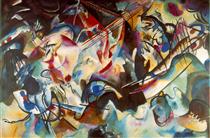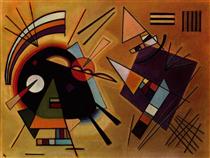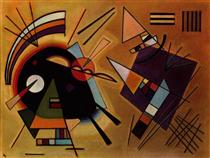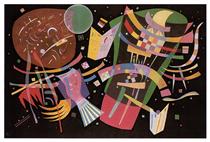
1866 - 1944
Wassily Kandinsky

description
Russian painter, writer and art theorist, one of the founders of Abstract art.
Kandinsky received a basic musical and art education in Odessa, Ukraine. After that, he studied law and economics in Russia. He had been interested in painting since childhood. “Every color has its mysterious life,” he said. However, only at the age of 30 did Kandinsky seriously decide to become an artist.
His works from 1896 to 1911 are mostly landscapes, built on dissonance of color. The game of color spots and lines gradually replaced images of the reality. In 1901, the artist founded an art association called “Phalange” in Munich and organized a school, in which he himself worked as a teacher.
From 1914 to 1922 the painter created semi-abstractions, impressionistic landscapes and romantic fantasies. In his abstract paintings, the geometrization of individual elements is intensified. The reasons for this lie in the process of simplification, as well as the avant-garde and artistic atmosphere of Moscow in those times.
Paintings created by the artist from 1922 to 1933 are full of light and strange humor, which reappeared in his late Parisian works.
From 1934 to 1944 Kandinsky did not use combinations of primary colors, but worked with soft and subtle colors. At the same time, his paintings from this period are full of life and energy. The artist named this period “a really picturesque fairytale”.
Key ideas:
– Kandinsky vigorously opposed his constructivist opponents. “If an artist uses abstract means of expression, it does not mean that he is an abstract artist, that does not even mean that he is an artist.” There are no less dead triangles (be they white or green) than dead hens, dead horses and dead guitars. Becoming a “realistic academician” is as possible as becoming an “abstract academician.” A shape without content is not a hand, but an empty glove filled with air,” the artist wrote.
– The artist developed and improved his theory: “Abstract art creates a new world, next to “the real”, with nothing in common with reality”.
– Kandinsky created a world of images, where abstraction was the language of forms that arose out of a desire for meaningfulness and vitality.
– Kandinsky was a synaesthete. According to him, each color has its own soul.
1866
1895
1901
1909
1918
1944
The birth of the artist
He decided to become an artist

“Phalange”

The artist founded the Neue Künstlervereinigung München group

He dealt with the cultural politics of Russia

The death of the artist

Wassily Kandinsky
On Artist
flow
Post-Impressionism
friends
Robert Delone
Alexey Yavlensky
Paul Klee
Franz Marc
Vadim Meller
artists
Oscar-Claude Monet
Georges Seurat
Aubrey Beardsley
Alexander Kuprin
Emil Nolde
Anton Azhbe
Edvard Munch
Aristarkh Lentulov
Paul Cezanne
Marianna Verevkina
Franz von Stuck
By Artist
flow
Abstract Art
friends
Robert Delone
Franz Marc
Henri Victor Gabriel Le Foconier
Lionel Feininger
Yefim Golyshev
Alexey Yavlensky
artists
Kazimir Malevich
Bela Kadar
Ellen Tesleff
Man Ray
Albert Bloch
Oscar Kokoschka
Joseph Albers
Egon Schiele
Georgia O’Keefe
Karl Otto Goetz
Nasrin Mohammedi
William Baziotis
Arshil Gorki
Hans Hoffman
Yuri Zlotnikov
Alfio Giuffrida
